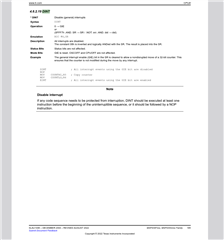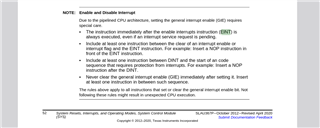- Ask a related questionWhat is a related question?A related question is a question created from another question. When the related question is created, it will be automatically linked to the original question.
This thread has been locked.
If you have a related question, please click the "Ask a related question" button in the top right corner. The newly created question will be automatically linked to this question.
Tool/software:
I've read as many of the user's guides and compiler manual sections as I can find on this topic, but I'm still trying to figure out for sure what the requirements around NOP's and EINT are. What seem to be the most relevant sections below for reference:



The need for a NOP() after DINT is obvious to me. That next instruction can still be interrupted, which could be surprising if you think interrupts are disabled and break some atomic contract you have.
The need for a NOP() after EINT also makes some sense to me, although it's a little weaker. If you have interrupts pending while GIE is unset, and you want to guarantee those are serviced before the next instruction after the EINT, you need a NOP guard. I at least can understand this, but I question whether or not your code is very robust if it relies on this. Couldn't the interrupt be asynchronously set during the NOP after EINT in which case you would start servicing it after that first instruction already made it in anyway?
I can also understand (the somewhat pathalogical) case where if you disable, then immediately re-enable interrupts there must be a NOP between.
What I don't understand is why you would need a NOP before EINT in general outside these specific circumstances. However, major RTOS projects seem to think this is the case, and CCS emits warnings about this. I personally, could really use some clarity on why these NOPs are required.
To summarize my question(s):
1) When is a NOP before EINT required?
2) What is synchronization hazard from not having a NOP before EINT?
3) If every DINT is followed by a NOP and every EINT is followed by a NOP is there still any hazard?
Thanks for any clarity you can provide!
The guide I am looking at, slau367 4.6.2.20, includes:
Include at least 1 instruction between the clear of an interrupt enable or interrupt
flag and the EINT instruction. For example: Insert a NOP instruction in front of
the EINT instruction.
Why? Perhaps it takes a cycle or two for those changes to propagate through the interrupt hardware and this prevents a problem. I do recall that the interrupt hardware does not handle the case of beginning to handle an interrupt and then have it vanish very well. This results in it not selecting the correct vector table entry and program execution going off the rails. It has been a month or three so I forget the specific thread.
I appreciate the reply, but I feel just as unclear about this...
If a flag is set while the NOP you added is executing isn't that the same as not having the NOP at all?
Is the only situation this matters if the previous instruction was DINT?
When is a NOP before EINT required?
It should be apply to all instructions when need to set or clear the general interrupt enable bit.
What is synchronization hazard from not having a NOP before EINT?
Not following these rules might result in unexpected CPU execution.
If every DINT is followed by a NOP and every EINT is followed by a NOP is there still any hazard?
Insert a NOP instruction in front of the EINT instruction, Insert a NOP instruction after the DINT, I do not have the test data so far, but just follow our comments that will avoid the unexpected CPU execution.
Yes, I'm trying to follow the comments, but the guidance in the comments is still unclear...
Repeating the 4 bullet points with how I'm trying to understand them:
1) The instruction immedaitely after the enable interrupts instruction (EINT) is always executed, even if an interrupt service routine is pending
-> implies to me a NOP after EINT may be necessary, but you don't mention this
2) Include at least one instruction between the clear of an interrupt enable or interrupt flag and the EINT instruction. For example: Insert a NOP instruction in front of the EINT instruction.
-> this is the most unclear one. describes the position of NOP as before the EINT, but that's because it's between the EINT and DINT? Is this not equivalent to a NOP after the DINT?
3) Include at least one instruction between DINT and the start of an [sic] code sequence that requires protection from interrupts. For example: Insert a NOP instruction after the DINT.
-> this is unambiguous and clear. Instruction after the DINT is not protected by disabled interrupts so need a NOP there. Got it.
4) Never clear the general interrupt enable (GIE) immediately after setting it. Insert at least one instruction in between such sequence.
-> Also seems mostly clear, although this seems to indicate again that a NOP is required after EINT and not before
Hi Larry,
After check the previous record about this issue, I think you can ignore the note above and just take care of the using below below:
We have found issue that when using ONLY if you have an EINT immediately followed by a DINT, an pending interrupt maybe not be executed. The work around here is to add a NOP between EINT and DINT.
**Attention** This is a public forum